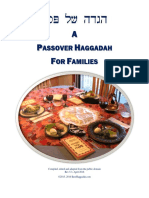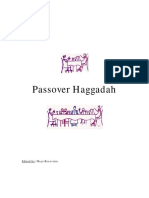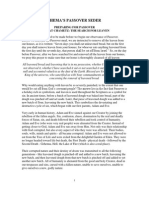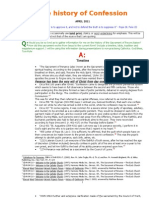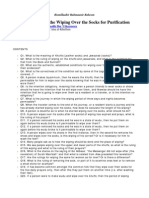Passover Guide
Uploaded by
peb1984Passover Guide
Uploaded by
peb1984PREPARING FOR AND CELEBRATING PASSOVER IN YOUR HOME Pre-Passover Information: Food and Utensils During Pesach (Passover)
The term Chametz or Leaven is applied not only to foods, the use of which are to be avoided during Pesach, but also to the dishes and utensils in which foods are prepared or served during the year, and which dishes or utensils may not be used during Pesach except as herein indicated. 1. FORBIDDEN FOR USE: The following foods are forbidden for use during Pesach: Leavened bread, cakes, biscuits and crackers, cereals, coffee substance derived from cereals, wheat, barley, oats, rice, dry peas and dry beans. All liquids which contain ingredients or avors made from grain alcohol. 2. PERMITTED FOODS: A. REQUIRING NO KOSHER LPESACH LABEL. The following foods are permitted in unopened packages or containers. They require no Kosher LPesach label: Natural coffee, sugar, tea, salt, pepper, vegetables (except peas and beans; string beans are permitted.) B. FROZEN FRUITS AND VEGETABLES. Fruits and those vegetables normally permitted for Passover use are permitted in their frozen state. C. IF CERTIFIED FOR PASSOVER USE BY RABBINICAL AUTHORITY. Matzah, matzah our, Passover noodles, candies, cakes, beverages, canned and processed foods, milk, butter, jams, cheese, jellies, relishes, dried fruits, salad oils, vegetable gelatin, shortenings, vinegar. Wines and liquors are permitted if they are certied by competent rabbinical authority as t for Passover use. Labels and tags marked Kosher LPesach are of no value unless they bear rabbinical signature. 3. Only Dishes and Utensils Specially Reserved for Passover Should be Used with the Following Exceptions: A. The silverware, knives, forks and spoons made wholly of metal though used during the year, may be used on Passover if thoroughly scoured and immersed in boiling water. All table glassware is permitted after thorough scouring. Fine translucent chinaware, if not used for a year, is permitted. B. Metal pots used for cooking purposes only (but not for baking) if made wholly of metal, though used during the year, may be used on Passover if rst thoroughly scoured and immersed in boiling water. C. Utensils used for baking during the year cannot be used during Passover. 4. Earthenware, enamelware and porcelain utensils used during the year may not be used on Pesach. Any vessel which cannot be thoroughly cleaned should not be used. 5. The stove is prepared for Pesach by thoroughly scrubbing and cleaning of all parts and turning on full ame in the bake oven and all the grates. 6. A dishwashing machine may be used for Passover after thoroughly scouring with boiling water and the use of a new tray. BEDIKAT CHAMETZ: CEREMONY FOR REMOVING LEAVEN Because Passover begins on Monday evening, March 25th, the ceremony of Bedikat Chametz will take place Sunday night, March 24th. The Biblical injunction, even the rst day shall you put away leaven out of your houses (Exodus 12:15) was interpreted by the Rabbis as referring to the day preceding Passover. To make sure that there be no leaven in your houses (Exodus 12:19), the Rabbis instituted a ceremonial search for leavened substances. As a religious ceremony, Bedikat Chametz is preceded by the benediction: Baruch atta Adonai Eloheynu melech ha-olam, asher kidshanu bmitzvotav vtzivanu al biur chametz. Blessed are You, Lord our God, Ruler of the Universe, who has commanded us concerning the removal of leaven. It is customary to place pieces of leaven in the house so the search will not be in vain. The leaven is gathered with a feather, wooden spoon and a candle. When the search is completed an Aramaic formula is recited, renouncing ownership of any leaven that may have escaped detection. (Children love this ceremony!) The next morning after breakfast the leaven of the night before is burned in a ceremony called Biur Chametz. A similar Aramaic formula is recited again renouncing ownership of any leaven. From this moment on no leaven may be eaten until the end of Pesach.
SUGGESTIONS FOR YOUR HOME SEDER 1. Make sure that everyone has a Haggadah. Select the one that you like best and is suited for the participants. The seder has been characterized as a hurried trip through Jewish history via the Haggadah - a panoramic cross section of Jewish life. 2. Don't feel that your seder must be too formal. You may interpolate into the various parts of the service your own comments. You may ask others to do the same. Keep the service moving along. But don't feel that it has quite the same formality as a synagogue service. The seder is a unique admixture of the solemn and the joyful. 3. Study the Haggadah before the night of the seder. Decide in advance which parts you can do in Hebrew and which in English. 4. Rotate the reading of the parts of the Haggadah among those at the table. Some will read in English; others will read in Hebrew. Some will sing the songs in one style; others will use another melody. The very melange of the Hebrew dialects and the variations in the manner of reading portions of the service will illustrate the diversity of Jewish life and add a special avor to the proceedings. 5. Have the guests recite as many of the blessings as possible in unison, and even certain segments can be read in unison so as to engage the attention of everyone. THE SEDER TABLE should be set as beautifully as possible with owers, ne silverware and sparkling linen in addition to lighted candles over which a blessing should be recited. On the table, there is a decorative plate which contains the symbols of Pesach: The Marror, the bitter herb, which leaves the bitter taste of slavery on our mouths; the Charoset, the mixture of apple, nuts and wine, reminiscent of the mortar used in the work of slave labor in olden days when the Jews made bricks for Pharaoh. The roasted egg recalls the special sacrice offered in the Temple on all holidays; the roasted lamb bone stands for the paschal lamb which our ancestors ate this night each year before the destruction of our Temple, and the parsley and salt water. The parsley, eaten to indicate that Pesach is a spring festival, is dipped in salt water to remind us of the tears of the Hebrew slaves. THE AFIKOMAN is another symbol of Passover. Early in the service, the middle Matzah of the three that are on a plate covered by a napkin is broken in two. One portion is wrapped in a napkin and is hidden until the meal is nished. This portion is known as the Akoman. The custom of hiding the Akoman has developed from a desire to keep children who are at the seder alert until the conclusion. A prize is given to the child who later nds the Akoman. (You can give a prize to all the children recognizing their hard work in looking for the akoman.) THE FOUR QUESTIONS which are asked by the youngest child (or all the children) are called Mah Nishtanah, the rst two Hebrew words of the questions. The narrative of the Haggadah is the reply. THE CUP OF ELIJAH is kept lled with wine on the table in anticipation of the coming of Elijah pictured as the herald of the great Messianic era when all people will accept God's rule. During the service each person drinks four cups of wine which symbolizes the four fold promise of redemption which God pledged to Israel. HALLEL. Throughout the seder, we recite certain Psalms of David. Because they are psalms of praise, we speak of them as Hallel, which is the Hebrew word for praise. These psalms are regarded as the oldest portion of our Haggadah ritual. The seder is an occasion of joyous family reunion. A little effort on your part will bring you the satisfaction of knowing that you have created an inspiring event in your child's life which will remain a happy memory.
PASSOVER ANNOUNCEMENTS MAOT CHITTIM - The custom of donating money to a Maot Cittim Fund immediately before Passover is an ancient one. Maot Chittim means portions of wheat, referring to wheat needed to bake matzah. Since during Passover Jews may not eat bread or products that ferment, a special fund is established to assist the poor in purchasing Passover necessities. Please consider helping those not as fortunate as you are and send your contribution to the Rabbi Ira L. Korinow Chesed Fund. Checks can be made out to Temple Emanu-El and indicate Maot Chittim on the memo line. MECHIRAT CHAMETZ -It is customary before Passover to free ourselves of leaven in our homes via Mechirat Chametz, the selling of the leaven. Rabbi Korinow will be pleased to assist in the process. Please call him at the Temple ofce or ll in the written agreement to be found below and mail it to Rabbi Korinow with a contribution to buy it back after Passover. Chametz should be sold by the morning of Monday, March 25th PROJECT MAZON - In addition to selling your chametz, you may wish to donate this food to those who are hungry. If you can bring whatever food items you have to the Temple ofce by noon on Monday, March 18th, we will deliver it to a local organization for distribution to the needy. A monetary contribution can also be made to MAZON: A Jewish Response to Hunger. For an envelope, please call the Temple Ofce. SHARE YOUR PASSOVER SEDER - Passover has traditionally been a time when families, relatives and nonrelatives join together in celebration of the Passover seder. Many small families band together for the seder. Single individuals, like college students who are away from home, or others who have no family, need to be invited to a seder. Please call the Temple ofce to express your desire to be invited to a seder, or to express your desire to invite another family or individual to your seder. The Temple staff will serve as sensitive and careful Passover seder matchmakers.
------------------------------------------------------------------------------------------------------------------------------
Authorization for the Selling of Chametz
I authorize Rabbi Ira Korinow to sell my chametz to someone who is not Jewish in the community. I also agree to buy back my chametz at the end of Passover. Enclosed is my contribution to tzedakah (charity) for $ ____________ .
_________________________________ signature Please complete and return with a check made out to Temple Emanu-El for any amount to: Rabbi Ira Korinow Temple Emanu-El 514 Main Street Haverhill, MA 01830
You might also like
- The Seder Meal As A Christian CelebrationNo ratings yetThe Seder Meal As A Christian Celebration13 pages
- Yeshua in The Passover:: A Hebrew-Roots HaggadahNo ratings yetYeshua in The Passover:: A Hebrew-Roots Haggadah36 pages
- Final Version of Haggadah To Printer 3-12-07No ratings yetFinal Version of Haggadah To Printer 3-12-0749 pages
- A Messianic Family Haggadah Printweb Version 5No ratings yetA Messianic Family Haggadah Printweb Version 519 pages
- Leimgruber Family Haggadah Maundy Thursday 2020 ZedarNo ratings yetLeimgruber Family Haggadah Maundy Thursday 2020 Zedar12 pages
- Hebrew Haggadah Text With Instructional Guide - Passover PDFNo ratings yetHebrew Haggadah Text With Instructional Guide - Passover PDF75 pages
- Passover Seder Steps: The Four QuestionsNo ratings yetPassover Seder Steps: The Four Questions3 pages
- Messianic Passover Haggadah - Congregation Shema Yisrael100% (2)Messianic Passover Haggadah - Congregation Shema Yisrael17 pages
- One For Israel Family Passover Haggadah 2020 PDFNo ratings yetOne For Israel Family Passover Haggadah 2020 PDF18 pages
- Simplified Passover Dinner Service For Kids100% (1)Simplified Passover Dinner Service For Kids6 pages
- Sacred Name Passover Hagaddah For Scribt ReadersNo ratings yetSacred Name Passover Hagaddah For Scribt Readers10 pages
- The Wandering Is Over Haggadah (Second Edition)100% (2)The Wandering Is Over Haggadah (Second Edition)23 pages
- India Business Etiquette and Protocol GuideNo ratings yetIndia Business Etiquette and Protocol Guide0 pages
- TheLifeAndTeachingsOfSriMadhvacharyar C.m.padmanabhaChar1909No ratings yetTheLifeAndTeachingsOfSriMadhvacharyar C.m.padmanabhaChar1909471 pages
- The Tomb of Marie Laveau in St. Louis Cemetery No. 1, A Lecture Sponsored by Save Our CemeteriesNo ratings yetThe Tomb of Marie Laveau in St. Louis Cemetery No. 1, A Lecture Sponsored by Save Our Cemeteries24 pages
- Vadakalai Tenkalai Doctrinal DifferencesNo ratings yetVadakalai Tenkalai Doctrinal Differences47 pages
- MacCormack Sabine-Art and Ceremony in Late Antiquity-University of California Press (1981)No ratings yetMacCormack Sabine-Art and Ceremony in Late Antiquity-University of California Press (1981)129 pages
- Nishita Kaal Puja Time 23:23 To 24:13: Duration 0 Hours 49 Mins On 5th, Maha Shivaratri Parana Time 05:59 To 14:43No ratings yetNishita Kaal Puja Time 23:23 To 24:13: Duration 0 Hours 49 Mins On 5th, Maha Shivaratri Parana Time 05:59 To 14:431 page
- Afro-Brazilian Altar - Poems - The Textual Poetics of Pontos - RiscadosNo ratings yetAfro-Brazilian Altar - Poems - The Textual Poetics of Pontos - Riscados18 pages
- Memories of The Kehillas Frankfurt of My Youth: Willie I. Neuberger Z"LNo ratings yetMemories of The Kehillas Frankfurt of My Youth: Willie I. Neuberger Z"L17 pages
- January 2014 (Philippines) : Sun Mon Tue Wed Thu Fri SatNo ratings yetJanuary 2014 (Philippines) : Sun Mon Tue Wed Thu Fri Sat12 pages
- Confession-The Sacrament of ReconciliationNo ratings yetConfession-The Sacrament of Reconciliation100 pages
- Do You Know The Aim of Life - ' The Guru Business - The New York TimesNo ratings yetDo You Know The Aim of Life - ' The Guru Business - The New York Times12 pages
- Canto Seven Chapter 15, Srimad Bhagvatam, SummaryNo ratings yetCanto Seven Chapter 15, Srimad Bhagvatam, Summary3 pages


















